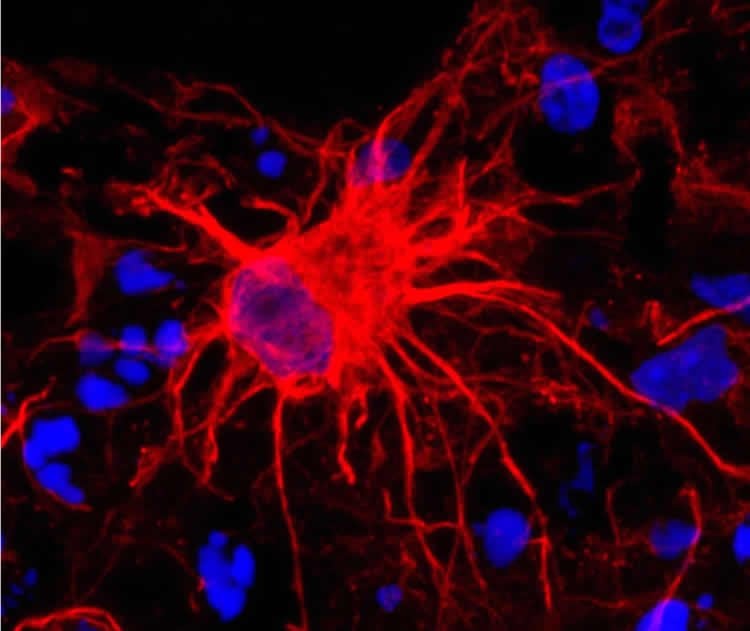Summary: A new study in Biological Psychiatry reports researchers discovered astrocytes may contribute to the cause of ASD. The findings could help to develop new treatments for autism spectrum disorders.
Source: Elsevier.
Using human induced pluripotent stem cells (iPSCs) to model autism spectrum disorder (ASD), researchers at the University of São Paulo, Brazil and University of California, San Diego have revealed for the first time that abnormalities in the supporting cells of the brain, called astrocytes, may contribute to the cause of the disorder. The findings, published in Biological Psychiatry, help explain what happens at a biological level to produce ASD behavior, and may help researchers identify new treatments for patients with the disorder.
Astrocytes play an important role in the development and function of the nervous system. But until now, iPSC models of autism have neglected their contribution. The new study, led by Dr. Patricia Beltrão-Braga and Dr. Alysson Muotri, used iPSCs to generate neurons and astrocytes to model the interaction between these brain cells and better understand how the brain forms in the disorder.
“This new use of pluripotent stem cells suggests that neurobiological approaches to autism based solely on abnormal neuronal development may fail to account for complex interplay of neurons and astrocytes that may be an underappreciated component of the biology of this disorder,” said Dr. John Krystal, Editor of Biological Psychiatry.
Induced pluripotent stem cell technology allows researchers to reprogram human cells into any cell in the body. In the study, first authors Dr. Fabiele Russo and Beatriz Freitas and colleagues used cells from three patients diagnosed with ASD and three healthy individuals to generate neurons and astrocytes. Neurons derived from ASD patients had less complex structure than healthy neurons, but adding healthy astrocytes to the ASD neurons improved their poorly developed structure. In reverse, pairing ASD astrocytes with healthy neurons interfered with their development, making them look more like the neurons from ASD patients.
“The article highlights for the first time the influence of astrocytes in ASD, revealing that astrocytes play a fundamental role in neuronal structure and function,” said Beltrão-Braga.

The researchers further investigated how the astrocytes exert their influence, and pegged a substance that astrocytes produce called IL-6, already suggested as a player in ASD, as the culprit for the defects. Astrocytes from the patients with ASD appeared to be producing too much of the substance, and the findings suggest that reducing IL-6 could be a beneficial treatment for neurons in ASD.
Importantly, ASD has been a challenging disease to model using iPSCs because of its complexity. Several genes have been linked to ASD, but their contributions remain unknown, and genetic differences between patients have made it difficult to understand the cause and develop treatments for the disorder. But in this study, the ASD subjects were selected because they shared similar behaviors, rather than similar genes. According to Beltrão-Braga, this means the findings could provide a new alternative strategy for treating ASD symptoms, independent of the patient’s genotype.
Source: Rhiannon Bugno – Elsevier
Publisher: Organized by NeuroscienceNews.com.
Image Source: NeuroscienceNews.com image is for illustrative purposes only.
Original Research: Abstract for “Modeling the Interplay Between Neurons and Astrocytes in Autism Using Human Induced Pluripotent Stem Cells” by Fabiele Baldino Russo, Beatriz Camille Freitas, Graciela Conceição Pignatari, Isabella Rodrigues Fernandes, Jonathan Sebat, Alysson Renato Muotri, and Patricia Cristina Baleeiro Beltrão-Braga in Biological Psychiatry. Published online November 9 2017 doi:10.1016/j.biopsych.2017.09.021
[cbtabs][cbtab title=”MLA”]Elsevier “iPSCs Show Astrocyte-Neuron Impact on Brain Pathology in Autism.” NeuroscienceNews. NeuroscienceNews, 10 November 2017.
<https://neurosciencenews.com/ipsc-neuon-astrocyte-autism-7916/>.[/cbtab][cbtab title=”APA”]Elsevier (2017, November 10). iPSCs Show Astrocyte-Neuron Impact on Brain Pathology in Autism. NeuroscienceNews. Retrieved November 10, 2017 from https://neurosciencenews.com/ipsc-neuon-astrocyte-autism-7916/[/cbtab][cbtab title=”Chicago”]Elsevier “iPSCs Show Astrocyte-Neuron Impact on Brain Pathology in Autism.” https://neurosciencenews.com/ipsc-neuon-astrocyte-autism-7916/ (accessed November 10, 2017).[/cbtab][/cbtabs]
Abstract
Modeling the Interplay Between Neurons and Astrocytes in Autism Using Human Induced Pluripotent Stem Cells
Background
Autism spectrum disorder (ASD) is a neurodevelopmental disorder with unclear etiology and imprecise genetic causes. The main goal of this work was to investigate neuronal connectivity and the interplay between neurons and astrocytes from individuals with nonsyndromic ASD using induced pluripotent stem cells.
Methods
Induced pluripotent stem cells were derived from a clinically well-characterized cohort of three individuals with nonsyndromic ASD sharing common behaviors and three control subjects, two clones each. We generated mixed neural cultures analyzing synaptogenesis and neuronal activity using a multielectrode array platform. Furthermore, using an enriched astrocyte population, we investigated their role in neuronal maintenance.
Results
ASD-derived neurons had a significant decrease in synaptic gene expression and protein levels, glutamate neurotransmitter release, and, consequently, reduced spontaneous firing rate. Based on co-culture experiments, we observed that ASD-derived astrocytes interfered with proper neuronal development. In contrast, control-derived astrocytes rescued the morphological neuronal phenotype and synaptogenesis defects from ASD neuronal co-cultures. Furthermore, after identifying interleukin-6 secretion from astrocytes in individuals with ASD as a possible culprit for neural defects, we were able to increase synaptogenesis by blocking interleukin-6 levels.
Conclusions
Our findings reveal the contribution of astrocytes to neuronal phenotype and confirm previous studies linking interleukin-6 and autism, suggesting potential novel therapeutic pathways for a subtype of individuals with ASD. This is the first report demonstrating that glial dysfunctions could contribute to nonsyndromic autism pathophysiology using induced pluripotent stem cells modeling disease technology.
“Modeling the Interplay Between Neurons and Astrocytes in Autism Using Human Induced Pluripotent Stem Cells” by Fabiele Baldino Russo, Beatriz Camille Freitas, Graciela Conceição Pignatari, Isabella Rodrigues Fernandes, Jonathan Sebat, Alysson Renato Muotri, and Patricia Cristina Baleeiro Beltrão-Braga in Biological Psychiatry. Published online November 9 2017 doi:10.1016/j.biopsych.2017.09.021






